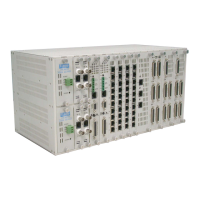CHAPTER 1 PRODUCTION DESCRIPTION
1
1. PRODUCTION DESCRIPTION
1.1. Description
Loop Telecom’s TDMoE plug-in card is designed for the Loop-AM3440 series. TDMoE card is used to
transport TDM traffic over IP network, in addition to Ethernet traffic. As the communications network
migrates from TDM to IP, the TDMoE card provides a flexible and cost effective choice for the transport
of legacy TDM signals.
It provides four Ethernet ports with no limitation for WAN or LAN port assignment: two aggregate ports
with GbE combo interface and two tributary ports with 10/100/1000 BaseT Ethernet interfaces. The
TDMoE card support point-to-point and point-to-multi-point voice and date application.
For transport of TDM signals E1, T1, Jitter and Wander adheres to G.823 Traffic and G.823
Synchronous.
1.2. TDMoEthernet ─ Theory of Operation
Over the past few years, packet-switched network (PSN) coverage has become ubiquitous, stimulating
a desire for convergence of all communications services over a unified infrastructure. This has brought
into prominence the concept of a pseudowire (PW). A pseudowire emulates a native service (e.g., ATM,
frame-relay, Ethernet or TDM) but utilizes transport over a PSN.
TDM over Ethernet, or TDMoEthernet, is a TDM PW technology that makes it possible to provision E1,
T1, and serial data services across IP, MPLS or layer 2 Ethernet networks. The services are provided in
a manner transparent to all protocols and signaling. TDMoEthernet enables service providers to
migrate to next generation networks while continuing to provide all their revenue-generating legacy
voice and data services, and without fork-lift upgrades of end-user equipment. TDMoEthernet also
benefits data carriers by enabling them to offer lucrative leased-line and voice services on their
packet-switched infrastructures. It enables enterprises to run voice and video over the same
IP/Ethernet-based network that is currently used to run only LAN traffic, thereby minimizing network
maintenance and operating costs.
Unlike other traffic types that can be carried over pseudowires, TDM is a real-time bit stream, leading to
TDMoEthernet having unique characteristics. In addition, conventional TDM networks have numerous
special features, in particular those required in order to carry voice-grade telephony channels. These
features imply signaling systems that support a wide range of telephony features, a rich standardization
literature, and well-developed OAM mechanisms. All of these factors must be taken into account when
emulating TDM over PSNs.
One critical issue in implementing TDM PWs is clock recovery. In native TDM networks the physical
layer carries highly accurate timing information along with the TDM data, but when emulating TDM over
PSNs this synchronization is absent. TDM timing standards can be exacting, and conformance with
these requires innovative mechanisms to adaptively reproduce the TDM timing. TDMoEthernet ensures
that recovered clock jitter and wander levels conform to ITU-T G.823/824, even for networks that
introduce high packet delay variation and packet loss.
TDMoEthernet complements VoIP in those cases where VoIP is not applicable, and in those cases
where VoIP price/performance is not optimal. Most importantly, TDMoEthernet can provide higher voice
quality with much lower latency than VoIP. And unlike VoIP, TDMoEthernet can support all applications
that run over E1/T1 circuits, not just voice. TDMoEthernet can provide traditional leased-line services
over IP, and is transparent to protocols and signaling. Because TDMoEthernet provides an evolutionary
(as opposed to revolutionary approach), investment protection is maximized.

